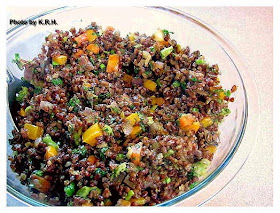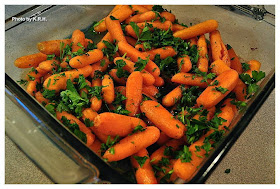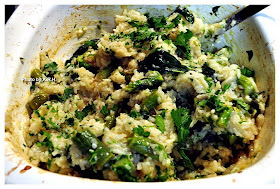I’ve recently gotten into the habit of writing reviews on Amazon - try it and you’ll soon discover it can be addictive! Mostly I write reviews for cook books or other vegan-related items - you know, to rally support! And it recently occurred to me that I’ve never actually written a cook book review here. Since this blog is primarily about food and cooking that seemed absurd to me and so I thought it was high-time I rectify that.
 |
| Every Day Quinoa Chickpea Salad |
To start with I decided to pick “Appetite for Reduction” by Isa Chandra Moskowitz because this is seriously one of my favorite cook books ever. Along with Colleen Patrick-Goudreau's "The Vegan Table,” "Appetite for Reduction was one of the very first vegan cook books I ever received. I was given it as a Christmas gift in 2010 near the very beginning of my vegan journey and so for me this book was an excellent primer, it taught me a lot of basic tools, and techniques for vegan cooking. Not to mention the new ingredients, flavor combinations and ideas it introduced me to.
 |
| Lentil Eggplant Chili Mole with Scallion Corn Bread |
There is so much about this book I absolutely love and hold dear. The layout is fantastic the recipes are all laid out nicely in an easy to read font, and they’re mostly kept to one page. Instructions are minimal but precise and easy to follow. The ingredients lists - for the most part - are short, and most items are common pantry staples. I really love Isa’s conversational tone and style, her introduction and recipe headings are a joy to read, and add that extra something that every cook book should strive to have. She’s funny, witty, and has good stories about the creation of the dishes, which is something I really like because I’m always curious to know how an author happened upon a particular dish or flavor combination. I also like that she takes the trouble to suggest dishes to pair with each recipe. This works out really great because sometimes a dish sounds awesome, but you just can’t decide - or don’t know - what to pair it with. This was especially helpful in the early days of my veganism. I also love all the helpful hints, tips and tricks that pepper the book - again, invaluable information to a newbie!
 |
| Jerk Asparagus |
Now, some people have complained that the recipes are ‘too’ low-calorie, but that is exactly the intention of the book. If you’re not on a strict diet, or don’t care about being low-cal, you can still get benefit from this book, and it’s easy enough to amp up the calories if you like. For instance instead of using 1 tsp of olive oil as suggested use 1 tbsp - this is what I do more often then not. Despite the fact that this book is designed for weight-loss, and weight-management I think there’s something in it for everyone. I know it’s a book I come back to time and time again even though by now I own over 100 vegan cook books. There’s just something about this book, and the recipes that stole my heart. Oh - and speaking of calories, nutritional information is provided for each recipe for those of you who care about such things.
 |
| Cajun Beanballs and Spaghetti |
My only qualm with this book is it’s lack of photography. I'm a very visual person and I really hate it when a cook book has limited or no pictures. I love beautiful food photography and find that the pictures help inspire me to make the dishes. This book simply doesn't have enough pictures, and of the ones it does contain I feel they are not as beautiful as they could be.
 |
| Spicy Blue Potato and Corn Salad |
But, don’t let that get you down. The recipes will speak for themselves. Almost everything I’ve made from this book has been excellent, and I’ve made quite a few things. Such as the...
 |
| Trattoria Pasta Salad |
Everyday Chickpea Salad - LOVED IT - a `go-to' salad
Balsamic Vinaigrette - LOVED IT - a `go-to' dressing
Spicy Blue Potato and Corn Salad - Pretty good
Sushi Roll Edamame Salad - LOVED IT - a `go-to' salad
Green Onion Miso Vinaigrette - LOVED IT - a `go-to' dressing
Big Fat Taco Salad - pretty good
Quinoa Salad with Black Beans and Toasted Cumin Seeds - pretty good
Cool Slaw - pretty good
Wild Rice Salad with Oranges and Roasted Beets - LOVED IT
Tinfoil Beets - Love it - a good method
Orange Sesame Vinaigrette - LOVED IT
Caesar Salad with Eggplant Bacon - LOVED IT
Caesar Chavez Dressing - LOVED IT - perhaps one of the best Caesar dressings ever.
Vietnamese Rice Noodle Salad with Grilled Tofu - LOVED IT
Catalan Cous Cous Salad with Pears - Pretty good
Romesco Dressing - LOVED IT
Trattoria Pasta Salad with white beans - Pretty good
Sun Dried Tomato Walnut Dressing - LOVED IT
Strawberry Spinach Salad - pretty good.
Cauliflower Mashed potatoes - this was okay, but then as much as I love cauliflower I'm not all that fond of it mashed.
Silky Chickpea Gravy - LOVED IT
OMG Oven Baked Onion Rings - LOVED IT
Scallion Potato Pancakes - Loved it
Brussels Sprout-Potato Hash - LOVED IT
Bhutanese Pineapple Rice - Loved it
Polenta Stuffing - Pretty Good
Quinoa Puttanesca - Loved it
Soft Broccoli Polenta - this was okay, but at the time I made it I'd never eaten polenta before so maybe this needs a re-do.
Ethiopian Millet - Meh, not for me.
Butternut Coconut Rice - pretty good
Eggplant Kibbeh - I thought this was just okay, but my husband really liked it
Tamarind Quinoa - pretty good
Garlicky Mushrooms and Kale - loved it
Jerk Asparagus - loved it
Pineapple Collards - This was okay.
Mushroom tibs - pretty good
Orange Scented Broccoli - LOVED IT
Eggplant Dengaku - loved it
Herb Roasted Cauliflower with Breadcrumbs - pretty good
Ye'abesha Gomen - Pretty good
Curried Cabbage and peas - pretty good
Baked Falafel - LOVE IT this is my `go-to' falafel recipe
Chipotle Lentil Burgers - LOVED IT
Black Bean Zucchini and Olive Tacos - LOVED IT
Garlic Lemon Yogurt Sauce - pretty good
Mango BBQ Beans - pretty good
Black Beans in Red Velvet Mole - This was okay, but then I'm not the biggest fan of mole.
Curried Green Onion Hummus - loved it
Red Thai Tofu - pretty good
Lettuce Wraps with hoison-mustard tofu - LOVED IT
Curried Scrambled Tofu with Arugula - LOVED IT
Red Wine and Kalamata Tempeh - LOVED IT
Tamarind BBQ Tempeh with Sweet Potatoes - LOVED IT!
Buffalo Tempeh - LOVED IT
Fusilli Roasted Veggie Primavera - LOVED IT
Pasta con Broccoli - Loved it
Easy Breezy Cheezy Sauce - Pretty good
Spinach Linguine with edamame Pesto - LOVED IT
Edamame Pesto - LOVED IT
Ginger Bok Choy and Soba - LOVED IT
Pasta de los Angeles - LOVED IT
Spinach Lasagna with Roasted Cauliflower ricotta and Spinach - LOVED IT
Miso Udon Stir-fry with Greens and Beans - LOVED IT
Mac and Trees - Pretty good
Cajun Beanballs and Spaghetti - not a fan,
Black Eyed Pea and Tempeh Beanballs - I was not all that thrilled with this dish, but at the time I’d made it I’d never eaten tempeh before, nor black eyed peas. I think this would be a lot better upon a second try. I’ll let you know if I try it again.
Mom's Marinara - Loved it
Bistro Broccoli Chowder - pretty good
Arabian Lentil and rice Soup - LOVED IT
Manhattan Glam Chowder - Not for me, but then Mushrooms can be hit or miss for me.
Summer Loving Curried Corn and Veggie Chowder - LOVED IT
Red Lentil and Root Veggie Dal - pretty good
2nd Avenue Vegetable Korma - Loved it
Curried Chickpeas and Greens - LOVED IT
Potato-Spinach Curry - pretty good
Chipotle Chili with Sweet Potatoes and Brussels Sprouts - not for me
Lentil and Eggplant Chili Mole - pretty good
Fresh Corn and Scallion Cornbread - LOVED IT
Quinoa, Kale and White Bean Stew - Loved it
Portobello Pepper Steak Stew - LOVED IT
Moroccan Chickpeas and Zucchini - LOVED IT
Veggie Potpie Stew - LOVED IT
Sweet Potato Drop Biscuits - LOVED IT
Smokey Tempeh and Greens Stew - LOVED IT
Eggplant Provencal - Pretty good
 |
| Caesar Salad with Eggplant Bacon |
Overall this book is just amazing, really and truly. I’ve had such great success with it that I’d happily recommend it to any vegetarian, vegan, or omni. In fact I’ve made many dishes from this book for my omni friends and family and they’ve always been a hit. So if you haven’t got a copy of “Appetite for Reduction” yet, what are you waiting for? Go out there and grab a copy tout de suite! And if you do own a copy already, what do you think?
 |
| Bhutanese Pineapple Red Rice |
You can learn more about Isa and get some delicious recipes too over at her website The Post Punk Kitchen











































